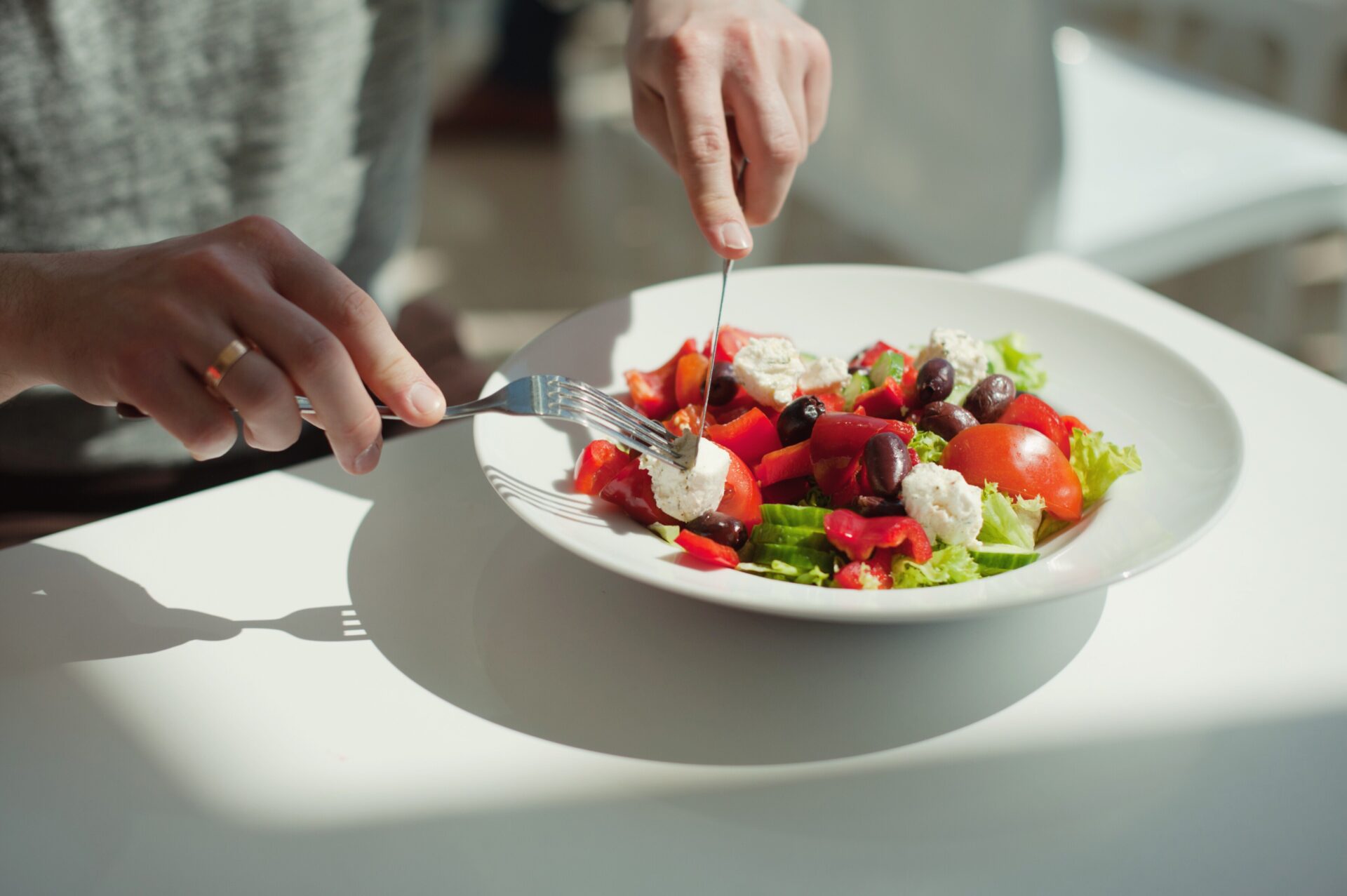If you're feeling like diet culture has done you wrong, you’re not alone — the constant cycle of weight-loss trends in the media can be overwhelming. In fact, approximately 8 million people in the U.S. struggle with disordered eating.
Enter intuitive eating, a non-diet approach to health and wellness that is designed to help you break the cycle of chronic dieting and cultivate a positive relationship between food, your body and your mind.
What is intuitive eating?
Founded by registered dietitians Evelyn Tribole and Elyse Resch, intuitive eating is a flexible approach to food that emphasizes trusting your body’s internal signals of hunger and fullness rather than relying on external rules or restrictions. "It involves tuning in to your body’s needs, desires, and cravings and making food choices that honor your physical and emotional well-being," explains Jessica Jones, R.D.
In practice, that means you'll need to closely tune into your body's hunger and fullness cues to determine when and how much to eat. "It's about giving yourself unconditional permission to eat what you want to eat when you are hungry and knowing the difference between physical and emotional hunger," says Melissa Prest, D.C.N., R.D.N., a national media spokesperson for the Academy of Nutrition and Dietetics and a member of the Prevention Medical Review Board.
10 guiding principles
In short, intuitive eating is all about learning how to take care of yourself in a holistic and comprehensive way, says Jones. But if you're used to following all the rules and regulations of diet culture, that may sound a bit abstract. So we tapped Jones to distinguish the 10 core principles of intuitive eating according to Tribole and Resch's program, and how to apply each in your everyday life.
- Reject the diet mentality. To start, let go of the idea that there is a "perfect" way to eat or that weight loss is the key to health and happiness.
- Honor your hunger. Listen to your body and eat only when you feel hungry, rather than following strict meal plans or counting calories.
- Make peace with food. Give yourself permission to eat any foods you enjoy without guilt or shame, and stop labeling foods as "good" and "bad."
- Challenge the food police. Think of the "food police" as the embodiment of all those ridiculous diet culture rules that dominate your feelings around eating. Instead, actively question the negative messages you may have internalized around certain foods or your body size.
- Respect your fullness. Take breaks while eating to tune in to your body's fullness signals (reduced desire to eat, not thinking about food, or feeling more energized). But remember: You are allowed to eat past the point of fullness and also to eat when you are not hungry.
- Discover the satisfaction factor. Find pleasure and satisfaction in your food choices! Food is meant to be enjoyed.
- Honor your feelings without using food. Do you always turn to food when you are sad, stressed, angry, or bored? It’s okay to use food as a coping mechanism sometimes, but if stress eating is your only coping strategy, it may be helpful to find other ways to work through your feelings rather than turning to the fridge.
- Respect your body. You wouldn't try to squeeze a size 10 foot into a size 7 shoe, would you? For the most part, we accept that our shoe size is genetic and don't get hung up on it. The same should go for respecting our bodies' unique shapes and sizes. Stop picking on yourself!
- Exercise — feel the difference. Focus on exercises that feel enjoyable and energizing to you, rather than routines that are punishing or exhausting.
- Honor your health. Don’t try to overhaul your diet overnight in the name of "health and wellness." Focus on small changes that make you feel better and not worse. Jones recommends incorporating protein, carbohydrates, and fats into every meal, but it doesn’t need to be complicated or time consuming. "Protein helps to support muscle growth and repair, carbohydrates provide energy for the body and brain, and fats help to absorb important vitamins. I recommend that people aim for balance, because it will help provide sustained energy throughout the day."
Benefits
Intuitive eating research is ongoing, but thus far, studies have found that intuitive eating is linked to having a more positive emotional outlook, higher satisfaction with life, and greater body appreciation, as well as weight maintenance. But overall, it's important to remember that intuitive eating is not a weight-loss program or a diet.
"Being mindful of what you are eating and how you are feeling helps people to naturally eat less," says Prest, who adds that most diet plans are short-term fixes that lead to weight regain once the diet has stopped. "Intuitive eating is a way of eating that is sustainable for life leading to weight stability."
"It’s a way of life focusing on self-care, body respect, and your well-being over weight loss," adds Jones. "It can take time and practice to embrace intuitive eating fully, but it can help people transform their entire life and have a greater, healthier appreciation for their bodies."
Precautions
It's important to seek the support of a medical professional before starting any new eating plan, but especially if you have a history with eating disorders. "If someone has an active eating disorder, it’s best to consult a registered dietitian and health care team before implementing intuitive eating," advises Jones.
Getting started
If you think intuitive eating is an approach that could benefit you, here are a few ways to kick things off:
- Give yourself permission to eat. Most people are drawn to intuitive eating after getting burnt out by constant dieting without sustained results. "They are tired of the constant negative focus on weight, body image, and numbness to eating," says Prest. The first thing to do is make peace with food and allow yourself unconditional permission to eat. "This is hard work after years of eating off of strict lists or rules," she says. Prest also notes that this is a good time to explore food and truly figure out what you like and do not like to eat.
- Listen to your hunger and fullness signals. The next step is to hone in on your hunger and fullness cues to figure if you are physically hungry or emotionally hungry. "You also start to pay attention when you are feeling full and satisfied, not stuffed, but content," says Prest. "You are learning how to trust your body and yourself." As these behaviors set in, you'll start to feel physically better. "Most people find that foods that were triggers for them before are no longer concerns," she adds.
- Enjoy the food your body wants to eat. You also want to tune into your body’s cravings and food preferences, allowing yourself to enjoy them without guilt. "Pay attention to how your body feels after eating certain foods," says Jones. "For example, if you’re feeling lethargic, perhaps that food choice isn’t the best one for your body."
- Be patient and compassionate with yourself. "Practice self-compassion and kindness towards yourself," says Jones. Remember that, unlike diets, it’s impossible to "fail" at intuitive eating. Everything is a learning process, so be curious about your actions and the "why" behind your choices. Remember that this approach to eating is not a race. Go slow, have patience, and give yourself some grace. "Like any behavior change, the road is not a straight line and you will have setbacks," she says.
The bottom line
Intuitive eating is not a diet, but a body-positive approach to food that allows your internal cues of hunger and fullness to guide when, what, and how much you eat. If you're intrigued, you can work with health professionals that specialize in intuitive eating for support and guidance.
Madeleine, Prevention’s assistant editor, has a history with health writing from her experience as an editorial assistant at WebMD, and from her personal research at university. She graduated from the University of Michigan with a degree in biopsychology, cognition, and neuroscience—and she helps strategize for success across Prevention’s social media platforms.
from "healthy food" - Google News https://ift.tt/M4qNjZA
via IFTTT














